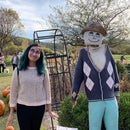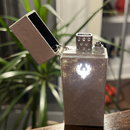Introduction: 3D Zoetrope
A zoetrope is a device that produces the illusion of motion from a rapid succession of static pictures (Wikipedia)
And a 3D zoetrope is the same except it uses static sculptures and models instead of pictures. Here's a simple zoetrope I made that can be run on a turntable.
Materials:
Cardboard (the size of the turntable)
Pipe cleaners
Paper maché
Stiff wire
Black (or any dark colored) paper
Turntable
Strobe light
And a 3D zoetrope is the same except it uses static sculptures and models instead of pictures. Here's a simple zoetrope I made that can be run on a turntable.
Materials:
Cardboard (the size of the turntable)
Pipe cleaners
Paper maché
Stiff wire
Black (or any dark colored) paper
Turntable
Strobe light
Step 1: Chalk Out the Steps of the Motion
The most important part is to divide the final motion of the zoetrope into a series of still figures such that the difference between two adjacent stills is not drastic. Keep in mind that this applies to the last and first stills as well, since they're in a loop.
I decided to simulate an ice-skater's toe loop jump since it starts and ends on the same leg; so if I play it in a loop it'll look like the skater's doing continuous jumps. I referred quite a few step-by-step tutorials for the jump and drew the above rough sketch
I have divided the final motion into 16 steps after noting that some successful zoetrope constructions had the same.
Note that this is not an accurate description of a toe loop. It's modified to get a continuous motion using pipe-cleaner models
I decided to simulate an ice-skater's toe loop jump since it starts and ends on the same leg; so if I play it in a loop it'll look like the skater's doing continuous jumps. I referred quite a few step-by-step tutorials for the jump and drew the above rough sketch
I have divided the final motion into 16 steps after noting that some successful zoetrope constructions had the same.
Note that this is not an accurate description of a toe loop. It's modified to get a continuous motion using pipe-cleaner models
Step 2: Make the Skeleton
Cut the cardboard to the size of the turntable, divide it into 16 parts and mount the "backbones" of the skater. The wires are fixed into paper maché balls for support.
(I made a sample skater model first to determine the size that would fit along the arc length of one division)
Using a wire backbone gives us the flexibility to adjust the height and position of the skater; it also helps increase the distance between 2 adjacent figures by making it bend outwards.
Paint the cardboard and the support balls black to prevent them from reflecting the light.
(I made a sample skater model first to determine the size that would fit along the arc length of one division)
Using a wire backbone gives us the flexibility to adjust the height and position of the skater; it also helps increase the distance between 2 adjacent figures by making it bend outwards.
Paint the cardboard and the support balls black to prevent them from reflecting the light.
Step 3: Make the Skater Models
Build a cylindrical screen out of black paper so that you don't see the models on the backside.
Referring the sketch, make skater models for each step using the pipe cleaners. Start with the heads(paper maché) and proceed to make the hands and legs. I used hot glue to glue them all up. Be sure to use only bright colors for the models as they stand out in the dark. Adjust the height of each model to show the jump sequence.
I added a small pony tail to highlight the movement of the skater.
Referring the sketch, make skater models for each step using the pipe cleaners. Start with the heads(paper maché) and proceed to make the hands and legs. I used hot glue to glue them all up. Be sure to use only bright colors for the models as they stand out in the dark. Adjust the height of each model to show the jump sequence.
I added a small pony tail to highlight the movement of the skater.
Step 4: Watch It Move!
Put it on a turntable, make the room dark, turn on your strobe light and watch it move!
(Adjust the strobe frequency to give you a smooth motion.)
Congratulations! Enjoy the satisfaction of seeing your static models (which took you so much time to build) do a 2 second, elegant jump ;)
P.S: I renamed the skaters as ballerinas since they don't really look like skaters. No skates! It was tough to accommodate skates in that tiny space. You can plan better to have a bigger circumference/ smaller models to do that. Also, I am lousy at building models I guess.
P.P.S.: You can adjust the speed of the turntable to make it look like the skater's moving backwards/ forward while jumping
(Adjust the strobe frequency to give you a smooth motion.)
Congratulations! Enjoy the satisfaction of seeing your static models (which took you so much time to build) do a 2 second, elegant jump ;)
P.S: I renamed the skaters as ballerinas since they don't really look like skaters. No skates! It was tough to accommodate skates in that tiny space. You can plan better to have a bigger circumference/ smaller models to do that. Also, I am lousy at building models I guess.
P.P.S.: You can adjust the speed of the turntable to make it look like the skater's moving backwards/ forward while jumping




